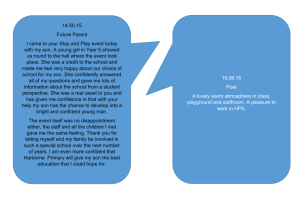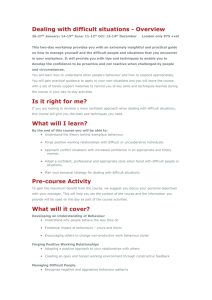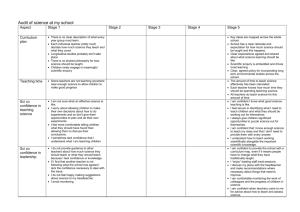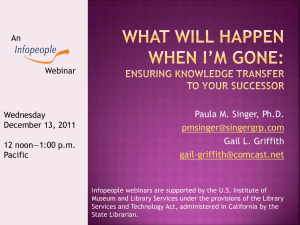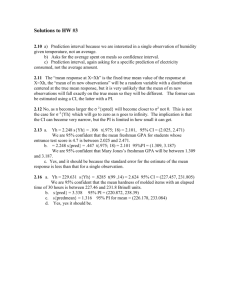Goal setting and action planning - Person
advertisement
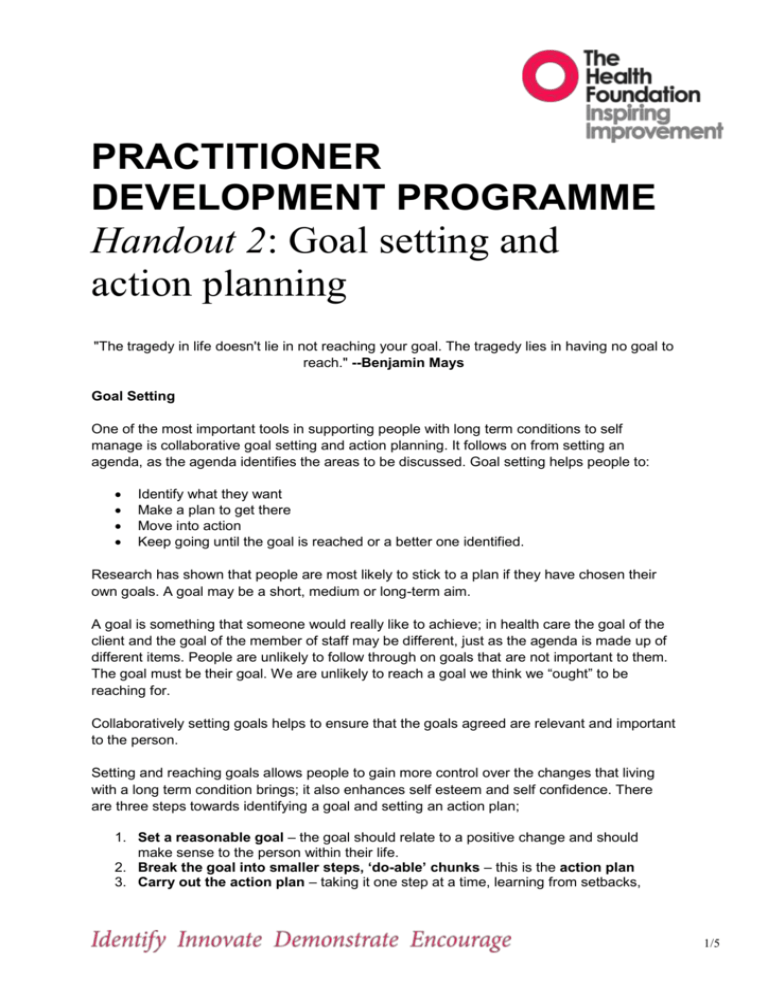
PRACTITIONER DEVELOPMENT PROGRAMME Handout 2: Goal setting and action planning "The tragedy in life doesn't lie in not reaching your goal. The tragedy lies in having no goal to reach." --Benjamin Mays Goal Setting One of the most important tools in supporting people with long term conditions to self manage is collaborative goal setting and action planning. It follows on from setting an agenda, as the agenda identifies the areas to be discussed. Goal setting helps people to: Identify what they want Make a plan to get there Move into action Keep going until the goal is reached or a better one identified. Research has shown that people are most likely to stick to a plan if they have chosen their own goals. A goal may be a short, medium or long-term aim. A goal is something that someone would really like to achieve; in health care the goal of the client and the goal of the member of staff may be different, just as the agenda is made up of different items. People are unlikely to follow through on goals that are not important to them. The goal must be their goal. We are unlikely to reach a goal we think we “ought” to be reaching for. Collaboratively setting goals helps to ensure that the goals agreed are relevant and important to the person. Setting and reaching goals allows people to gain more control over the changes that living with a long term condition brings; it also enhances self esteem and self confidence. There are three steps towards identifying a goal and setting an action plan; 1. Set a reasonable goal – the goal should relate to a positive change and should make sense to the person within their life. 2. Break the goal into smaller steps, ‘do-able’ chunks – this is the action plan 3. Carry out the action plan – taking it one step at a time, learning from setbacks, 1/5 Goals could relate to any area of a persons life; the self-management programme uses a three areas approach, helping participants to look at the biological, social, and emotional aspects of their condition. Goals may be set in any of these areas. They may flow naturally from the topics identified in the agenda. For example, someone may want to discuss financial issues or health issues. A goal could be to do something differently rather than something completely new. For example, “Instead of worrying about my next meeting with the consultant, I am going to spend 10 minutes writing down the things I want to talk about in the meeting.” If someone cannot think of anything, some prompts may be helpful. For example, Given how you feel today, can you imagine doing something between now and the next time we meet that might help you feel you are making a small step forward? What do you like doing that you haven’t done recently? What is it that you always wanted to do and you never found the time? If you could change one thing in your life, what might that be? Areas which might determine where the goals come from The service user’s agenda items The clinician’s agenda items Self-assessment tool Additional prompts and strategies: Would it be OK if I told you about some of the things that my other patients have set as goals? I wonder if you find that this helps you think about some of the things you might want to begin looking at. Some of my clients have found it helpful to think about this before the next appointment – I wonder if you might like to consider areas where you may want to begin looking at goals before we next meet? I’ve got some things for you to look at that might help you do this – would it be OK to show you these? Areas you could discuss include: Interpersonal/family relationships Health, fun and fitness Finances Hobbies and other interests Work and training Handout 2: Goal setting and action planning 2 It is important not to censor or try to talk the person out of a goal, unless it is something that puts others at risk! It is important to write the goal down, using a goal setting/action-planning sheet. Action planning This is the process of breaking the goal down into smaller, more do-able steps. It is the plan for how a goal will be reached. Action plans are more likely to succeed if they are SMART Action Plans S Specific – what is the person going to do? This should be phrased as a positive action “To go swimming’ rather than ‘not to sit around so much’ M Measurable – how much? How often? A Appropriate – something they want to do. How important is the action? R Realistic – how confident is the person that they can carry out the action? T Time-based – when will the action be carried out? A goal may require a number of smaller action plans. Based on the SMART framework, an action plan should specify: What you will do? How much? How often? How important this is to you? When you will do it? Imagining yourself doing this over the next week, how confident do you feel that you will complete the action plan? The role of importance and confidence When identifying a goal and putting together an action plan there are two things that can be very helpful in deciding whether the plan is appropriate and realistic. Importance is the first of these; check with the client that the goal is important enough for them to be working towards. As already noted, people are unlikely to work for goals that are not important to them. The best way to find this out is to ask directly, and using a scale to measure this can be very powerful “How important is it for you to reach this goal/carry out this action plan?” “On a scale from 0 – 10 how important is it, where 0 is not at all important, and 10 is that it is the most important thing in the world?” The second and equally important element is confidence – even if a goal is very important, the person may not feel confident in carrying out the action plan. Confidence can be measured in the same way as importance, using a ten-point scale Handout 2: Goal setting and action planning 3 “How confident are you that you can carry out this action plan?” “On a scale from 0 – 10 how confident are you, where 0 is not at all confident, and 10 is completely confident?” It has been found that in order to have a good chance of carrying out a plan, confidence needs to be 7 or more, so asking about it is very important. If confidence is less than 7, the aim of the next part of the conversation needs to be how to increase confidence. For example, ask “What stops you from feeling more confident?” “What needs to happen to move your confidence up from 4 to 5?” In checking out importance and confidence you may identify problems that are blocking the person from reaching their goals. When a problem is identified, it can be helpful to use a structured approach to tackling the problem. Enjoy the journey New behaviours are likely to extinguish unless they are rewarded; reward helps build momentum and confidence. Rewards can be: Intrinsic. The new behaviour is intrinsically rewarding and each step of the journey towards the goal reinforces the behaviour. A good example is someone newly diagnosed with diabetes who takes up and enjoys golf in order to manage their weight Extrinsic. The new behaviour is not intrinsically rewarding (and perhaps less so at the beginning of the journey), however it does bring long term health gain. A good example is someone who gives up smoking- the initial steps can be tough going. Supporting people to think of rewards linked to their behaviour change can help build initial momentum. Handout 2: Goal setting and action planning 4 Problem solving The problem solving cycle provides a simple approach to this. Briefly, the process involves 1. 2. 3. 4. Identification of the real problem Exploration of the problem Suggestion of ideas for solving the problem Choosing a solution to try out. Accept that some problems may not be solvable now Get more ideas from Identify the real proble m Choose another idea Explore the proble m Try it out Sugges t ideas Choose an idea It is a useful skill that can be applied to many areas of our lives. It is important that action plans are actively followed up with patients, ideally within 14 days. Handout 2: Goal setting and action planning 5
